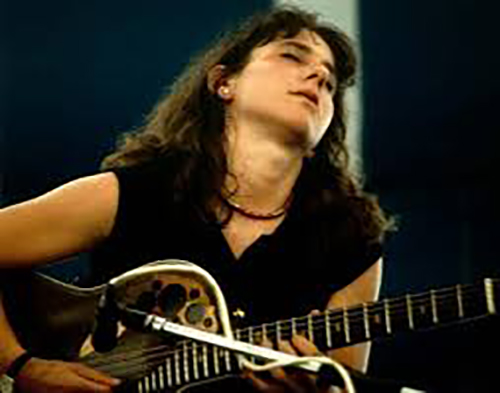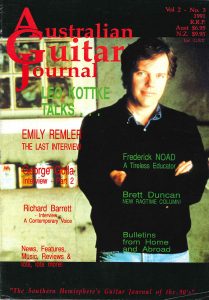
Emily Remler
In conversation with Greg Burdett
Less than one week after she gave this interview, in early May 1990, Emily Remler passed away suddenly in the midst of the Sydney leg of her Australian tour. Anyone who met her could not help but be impressed by her warmth and friendliness, and her willingness to share her passion for her art with her fellow musicians and students of the jazz guitar, whom she regarded as her “brothers and sisters.”
Share this:
[feather_share]
She will be very sadly missed and her work will not be forgotten.
New York born Emily Remler was winding down after a workshop with some of Melbourne’s keenest jazz guitar students at Melbourne’s Musicians Union Club. At thirty-two, with the release of her seventh album, “East meets Wes,” Emily was commencing her second tour of Australian capital cities. On a stroll around the streets of Windsor she made friends with as many of the local felines as she could and talked about her background.
She graduated from Berklee College of Music (Boston) in the late seventies and took up a job in the resident band of a hotel in New Orleans, where the competition was less than a place like New York. The experience of playing many different kinds of music behind visiting artists was to stand her in good stead later in her career.
“Berklee was good for learning theory and for meeting people. John Abercrombie, John Schofield, Mike Stern and Pat Metheny were all there at the same time as I was.”
“I met Herb Ellis and he introduced me to Carl Jefferson of Concord records and at nineteen I was playing with Herb, Jake Hanna and Tal Farlow, and I signed the recording contract at twenty-two. I was very fortunate. I never had to look for a record contract. They came after me; probably being a girl helped – uniqueness and all that. I moved back to New York after three years and proceeded to do local gigs around there with such great musicians as Eddie Gomez, Bob Moses, Sal Nestico, Hank Jones, Tommy Flanagan, Rufus Reid and McCoy Tyner, all as a result of being in New York.”
Remler has recorded with Larry Coryell (“Together” on Concord) and played concerts with Joe Pass, Herb Ellis, Barney Kessel, Charlie Byrd, Tal Farlow and Stanley Jordan. I expressed surprise that anybody could play a duet with Stanley Jordan – I mean, what was left for the second guitar to play? Says Emily, “I was chosen because I wasn’t pushy. I gave him a lot of space and just stuck in things when he wasn’t playing. The agents and promoters seem to like pairing guitar players up together. It’s sort of a gimmick. I don’t particularly like it actually. I prefer a trio (with bass and drums), or that and keyboard or a horn. My favourite duo player is Martin Taylor from Scotland; we play incredibly together; we don’t drop a beat all night. It was a lot like playing with George Benson, which I also did. When you get to a particular point there are certain great musicians who, for some reason, you don’t hook up with rhythmically, and with Martin I just hooked up with so well. After a certain point where everybody gets pretty good it’s a matter of personality, giving, ego, sharing, rhythm, you know.”
Remler tours with a cherry red Gibson ES330, “because it fits into the case that I have to bring on the plane.” She has just acquired a new custom made guitar that is practically a solid-body. “It’s one of the most interesting guitars that you’ll ever see. It’s a quarter inch thick and it has moveable pickups on a track so that at one end it sounds like a big fat ES175 (Gibson) and at the other end it sounds like a Strat (Fender). It’s quite amazing. Solid bodied guitars are good for beautiful sustained chords.”
On her approach to improvisation Remler says, “You learn by imitating the people you admire. Not a whole solo, you can’t digest that much at a time. You can start with just a four bar phrase, or try to imitate the feeling of a solo; and build a vocabulary, varying those phrases until they become your own. Memorising songs is important too, and getting to know the guide tones. For example, when Dm7 changes to G7 what is really happening is that C natural is changing to B natural. You can emphasise these guide tones in your solo. A solo should also have a beginning where you establish a melody, then a development, a climax and an ending. It is important to end a solo properly.”
Emily spoke enthusiastically about her new album, the first with a new independent record company entitled “Headfirst,” who had been willing to allow her to record more of her own compositions than had Concord, who preferred the more familiar standards.
On her latest album Emily uses a CASIO guitar-synthesiser for the first time. “It’s no big deal, it’s just a new piece of equipment so let’s use it and see what sounds it can produce. Let’s not discount the old stuff though! It gets back to the matter that any music is valid if you think it’s valid. Beethoven’s Seventh Symphony is as valid as a recorder piece in the Amazon. I can’t play country music like Chet Atkins so how can I put down country music?”.

